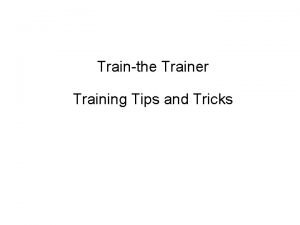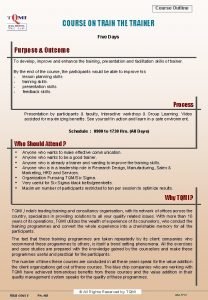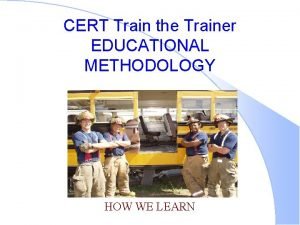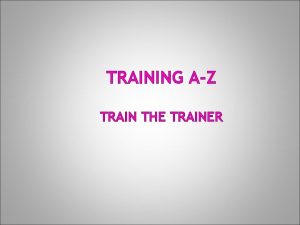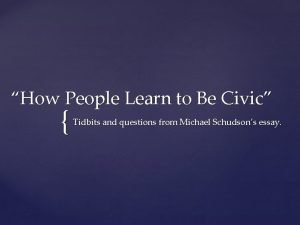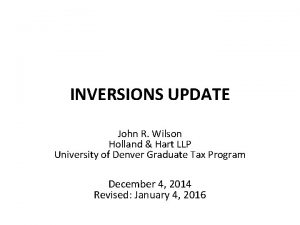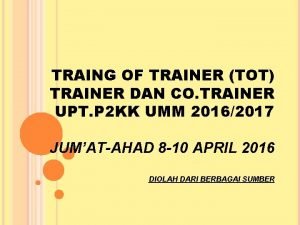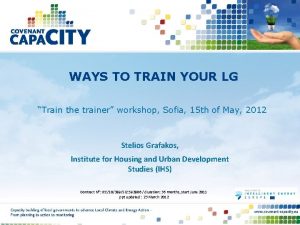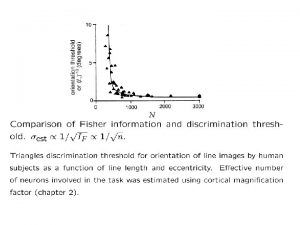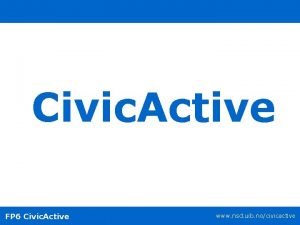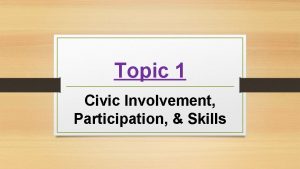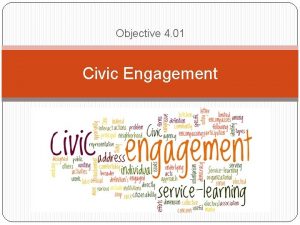Train the Trainer Hart Inter Civic Inc 6661

























































- Slides: 57

Train the Trainer © Hart Inter. Civic Inc. 6661 -008 A Verity_1. 0_Course Pack_TTT

Module 1 Getting Started

objectives After completing this course, trainees will successfully conduct the appropriate polling place operations course(s) in order to teach poll workers how to: • Operate the voting equipment • Instruct voters • Set up the polling place components • Assist voters • Suspend (and reopen) or close the polls, and • Pack up the equipment

benefits of Verity Usability – Verity makes election administration and voting easier, by providing user-friendly tools that reduce complexity and streamline productivity. • Modern, intuitive, friendly software design. • Innovative hardware that is easy to store, transport, set up and operate. • Usable, plain language ballot design and reporting.

benefits of Verity Adaptability – Verity is designed to support any kind of election, and to be flexible enough to change as your needs change. • Verity Election Office election management and the Verity Voting system follow a unique “ecosystem” approach that can respond to legislative changes and support new applications over the long term. • Modular parts allow Hart to convert Verity devices from electronic to paper and back, as your jurisdiction’s needs evolve.

benefits of Verity Transparency – Verity provides for open, secure and easily auditable elections. • Store images from Verity Scan scanning devices. • Robust filters to print and export ballot images from Verity Central, with adjudication notes, if desired. • Built-in Auditing Dashboard in Verity Count, to export Cast Vote Record data according to your specific needs. • Usable, easy-to-read plain language audit reports from every software application. • Easy, efficient methods to validate software on voting devices and desktop workstations.

Verity system overview Ballots Scanner v. Drive Polling Place Ballots Touch Writer Scan v. Drive

role of the Verity training specialist • Acquire knowledge • Create a positive training climate • Use time wisely • Treat trainees with respect • Be thorough • Assess trainee skills and coach • Use evaluations effectively

course content overview § Training Theory and Practice § Course Agendas § Preparing Equipment § System Expertise § Presentation Equipment and Skills § Review & Assessment

available resources Hart Inter. Civic Verity Support for Election Office staff and trainers o Customer Support Center (CSC) o Hart File Transfer (HTS) Hart Documentation o Polling Place Operations Guide o Train the Trainer Handbook

Hart Inter. Civic Verity Support The following resources are available for election office staff and trainers only; Poll Workers should not be encouraged to call the Hart CSC Help Desk: • Hart Customer Support Center (Help Desk) 1. 866. 275. 4278 hartsupport@hartic. com 7 AM-7 PM CST, extended hours during election events • Hart File Transfer Site (HTS)

Module 2 Training Theory and Practice

foundational training theories § Five Principles of Human Learning § Ten Concepts to Remember When Working with Adult learners § Knowle’s Principles of Adult Learning § The Six Stages of Learning

foundational training theories Five Principles of Human Learning Trainers can help facilitate successful training events by remembering: • A learning activity should be goal-directed • People learn what they practice • Learning is built upon the foundation of the previous step • Learners must make a personal connection • Activity and interest must be high

foundational training theories Ten Concepts for Working with Adult Learners • • • Must see the purpose and benefits Need positive reinforcement Must practice to retain information Associate new skills with past experiences Engage in learning that helps them cope with life changes Require clear expectations Demand comfort and breaks Need to see successful application of tasks May be impatient and want to “move on” Can be quick to evaluate good teaching

foundational training theories Knowle’s Principles of Adult Learning • Practicality Activities should be practical and “hands-on”. Experience (including mistakes) provides the basis for the learning activities. • Relevance Adult learners need to know “what’s in it for me? ” • Past Experience Adult learners (as well as the instructor) should tap into the experiences of other learners. • Task-oriented Adult learning is problem-centered rather than content-oriented. Adult learners need clear objectives.

foundational training theories The Six Stages of Learning Teaching Displaying skill and confidence Getting Competent comfortable Practicing Just trying Novice Advanced Beginner Experienced r P f to e c i t ac e un g o d le Am w Kno Being creative Proficient Master/Expert

training theory & practice Exercise 2. 1 Discussion. Tell about a successful training event you experienced as an adult. What were the positive aspects? What were the benefits? What made it so?

training methodology § The Hart Five Step Teaching Method § Basic Training Rules § Telling alone is not Training § Course Presentation Methods

training methodology The Hart 5 Step Teaching Method 5 Elicit 4 Review 3 Encourage Progress Hands-on 2 Show 1 Tell r P f e c i t ac o t e n g u o d le Am w o Kn Questions Aim For Mastery

training methodology The Hart 5 Step Teaching Method Step 1: Tell • Objectives • Purpose • Sets expectations

training methodology The Hart 5 Step Teaching Method Step 2: Show • Projector • Equipment demonstration • Video

training methodology The Hart 5 Step Teaching Method Step 3: Encourage Hands-on • Highest retention • Keep equipment/trainee ratio low • Holds trainees accountable I hear and I forget; I see and I remember; I do and I understand.

training methodology The Hart 5 Step Teaching Method Step 4: Review • Objectives • Steps • Key Points & Exam Questions • Purpose

training methodology The Hart 5 Step Teaching Method Step 5: Elicit Questions • Use positive reinforcement, • Encourage discussion and questions, • Facilitate participation by asking questions.

training methodology Basic Training Rules • • • Dress professionally Use training documents Start on time Tell objectives and steps Encourage questions when appropriate Remain flexible Work with your strengths End on time No cell phones Telling alone is not training

training methodology Training Methods • Presentation • Demonstration with Voting Equipment • Hands-on Exercises • Discussion Exercises • Question & Answer

training theory & practice Exercise 2. 2 Discussion. Give an example of something you are good at. How would you teach someone else to do it? Does it follow the basics of our training methodology? How?

planning overview Planning for the ideal training environment • Location: Where will you train? • Classroom: How will you set up? • Time: How long will you have? • Trainees: What is the class size? • Equipment: What do you need? • Documentation: What will trainees need?

planning overview Planning tools • Course Packs o Course Agenda o Equipment List o Classroom Layout o Presentation • Documentation o Polling Place Operations Guide o Logs and Labels Pack

training theory & practice Exercise 2. 3 Review agendas, documentation, equipment lists, and classroom layouts provided. Where can we train in this jurisdiction? How will we work around the physical space challenges?

Module 3 Course Agendas

course agendas • Adapt agendas to fit your jurisdiction’s resources and needs • Know the course prerequisites: make sure trainees have the appropriate background for the course you are teaching • Plan your classroom layout and materials needed beforehand

course content: polling place operations Polling Place Operations Verity Touch Writer & Verity Scan Module 1: Getting Started Presentation only, 5 minutes Module 2: Setting up the Polling Place Presentation and Hands-On, 25 minutes Module 3: Start of Day Procedures Presentation only, 5 minutes Module 4: Working with Voters Presentation only, 15 minutes Module 5: End of Day Procedures Presentation only, 10 minutes Module 6: Simulated Polling Place Exercise Hands on in groups with instructor guidance, rotating roles, 45 minutes Module 7: Review and Conclusion Presentation and Q&A, 10 minutes/variable

course content: APWD Assisting Persons with Disabilities Module 1: Getting Started “Putting People First” Presentation & Discussion, 15 minutes Module 2: Assisting A Voter Who is Blind or Visually Impaired Presentation and Hands-On, 20 minutes Module 3: Assisting a Voter with Limited Dexterity Presentation and Hands-On, 20 minutes Module 4: Assisting A Voter With Sip-and-Puff Device Presentation & Discussion, 10 minutes Module 5: Curbside Voting (Verity Touch Only) Presentation and Hands-On, 20 minutes Module 6: Polling Place Accessibility and Troubleshooting Presentation & Discussion, 20 minutes Module 7: Review and Conclusion Presentation and Q&A, 15 minutes/variable

course agendas Exercise 3. 1 Read through and discuss applicable course agendas, referencing documentation and presentations, in detail.

instruction groups Exercise 3. 2 Divide into groups of 2. Each group prepare for 15 -20 minutes to instruct the rest of the class in one of the modules using the materials and methods recommended in the training handbook. Trainers should use the Hart fivestep training method and identified presentation formats in their presentations.

system expertise Exercise 3. 3 Rotate modules and roles and practice training as per Exercise 3. 2.

Module 4 Preparing Equipment

equipment preparation In the Verity system, v. Drives are used to transfer ballots from software to device for voting, and to transfer voted ballots to software for tabulation. v. Drives also carry the audit log for their associated device to ensure voting remains fair.

equipment preparation Predefining Procedure Checklist q Power on the voting device q Unlock the v. Drive compartment and insert a new, unvoted v. Drive for your training election q Verify information, then tap Yes, load new election q Insert Verity Key and type the Key passcode q Type the Maintenance Code for the election you are using q Select the appropriate polling place from this list q Tap Accept q Tap Yes, assign it to confirm the polling place

equipment preparation Exercise 4. 1 Practice installing v. Drives and predefining equipment.

Module 5 System Expertise

hardware strengths • Innovative hardware is easy to store, transport, set up & operate • Modern, shared interface design makes learning easy • Minimal steps required for testing, setup, and maintenance • Secure, integrated compact cases for devices require less warehouse space • Secure, lightweight ballot box that folds to 5” thin • Lightweight, easy to assemble booth with minimal connections • Everything fits easily in private vehicles

Verity security features verity security features • Verity Voting utilizes the AAA (authentication, authorization, and audit) security framework. • All Verity software has been tested by an independent test lab to ensure proper security. • Verity uses a multi-layered authentication process. • Verity software is tamper evident; any attempts to alter the function of the software would be evident when tested. • Comprehensive audit logs are generated for all login attempts, data transfers, configuration changes, and errors. Logs are stored redundantly and securely. • Vote records are stored redundantly for security and auditability, risk mitigation and disaster recovery. • The integrity of the data is protected from power outage, power surge, magnets, and rough handling.

Verity security features Verity Key is a small security device that is programmed for each election. Verity Key is inserted into a USB port. Verity Key is part of Verity’s two-factor authentication process. Twofactor authentication requires each user to both have something (a programmed Verity Key) and to know something (the passcode associated with the Verity Key). Critical operations within the Verity Voting system require the Verity Key to be inserted and the passcode to be entered. Only when the Verity system authenticates the Verity Key and password will it allow the operation to continue.

security recommendations Polling Place Security Recommendations • Restrict access to voting equipment behind locked doors when not in use • Ensure chain of custody when delivering or transferring any voting equipment or ballots. • Maintain documentation for authentication purposes containing serial numbers, seal numbers and identification to anyone tasked with delivery or transport. • Do not leave voting equipment unattended when polling place is open. • Put in place and follow local guidelines relating to device seals and chain of custody procedures, including what to do if a seal is broken. • Put in place and follow Access Code procedures. Do not issue Access Codes or ballots until voter has been qualified and there is an available voting booth. • Report any suspicious activity to the local election officer.

troubleshooting Use a Systematic Approach q Remain calm q Identify the issue or symptoms as reported q Gather further information o Think broadly o Do not jump to conclusions o Ask questions q Establish a theory to explain the source of the problem q Research resolution steps based on your theory q Use available documentation to identify the resolution steps q Attempt resolution q Check for success q Repeat

Module 6 Presentation Equipment and Skills

presentation equipment Presentation Equipment • LCD Projector • Laptop(s) • Amplifier and Speakers

presentation equipment Exercise 6. 1 Practice setting up and operating presentation equipment.

presentation skills Presentation Skills • In Lecture • During Lab • Leading Q&A • During Simulation • Leading Review • With Presentations

presentation skills Exercise 6. 2 Rotate modules again. Present and critique. Use presentation feedback (as in exercise 3. 2) to frame performance feedback.

Module 7 Review, Assessment & Conclusion

Q&A Questions?

assessment Trainee Exam

trainer agreements Exercise 7. 1 Trainees complete exams in allotted time. Collect, score, review, and distribute nondisclosure agreements.
 Civic and citizenship
Civic and citizenship Differences between duties and responsibilities
Differences between duties and responsibilities Hrt 2 hrt
Hrt 2 hrt Train the trainer tips and tricks
Train the trainer tips and tricks Train the trainer training program outline
Train the trainer training program outline Train station renovation trainer
Train station renovation trainer Cert train the trainer
Cert train the trainer Train the trainer agenda
Train the trainer agenda Train the trainer objectives
Train the trainer objectives Brampton civic hospital pharmacy
Brampton civic hospital pharmacy How did washington show civic virtue
How did washington show civic virtue Tessa sutton
Tessa sutton Web design civic
Web design civic Civic space collaborative
Civic space collaborative Timbergrove station
Timbergrove station Audrey howatt
Audrey howatt Civic artifacts
Civic artifacts What is business idea
What is business idea Center for civic design
Center for civic design Gas leak
Gas leak Civic engagement meaning
Civic engagement meaning Civic event definition
Civic event definition Examples of civic artifacts
Examples of civic artifacts Civic education adalah
Civic education adalah Civic mirror hidden agendas
Civic mirror hidden agendas Civic humanism meaning
Civic humanism meaning Civic action project
Civic action project Civic mirror hidden agenda
Civic mirror hidden agenda Be civic
Be civic Whats the definition of virtue
Whats the definition of virtue Civic infobc
Civic infobc California seal of civic engagement
California seal of civic engagement Civic infotech
Civic infotech Civic actors examples
Civic actors examples Dylan thomas wikipedia
Dylan thomas wikipedia Holland & hart
Holland & hart Scala della partecipazione di hart
Scala della partecipazione di hart Hart plain infant school
Hart plain infant school Red bull inn
Red bull inn Valentina draksler
Valentina draksler Hart learning group
Hart learning group College waregem menu
College waregem menu Omdat gij het zijt
Omdat gij het zijt Rabo hart van brabant
Rabo hart van brabant Chlorophyta
Chlorophyta Die ruhe ist dem menschen heilig
Die ruhe ist dem menschen heilig Lucy hart paulson
Lucy hart paulson Zorg in hart van brabant
Zorg in hart van brabant Hart van aanbidding tekst
Hart van aanbidding tekst Grote en kleine circulatie
Grote en kleine circulatie Esbach reagent composition
Esbach reagent composition Alvaro acosta de hart
Alvaro acosta de hart Maud hart lovelace award
Maud hart lovelace award Uit het oog uit het hart frans
Uit het oog uit het hart frans Fluke 789 loop power
Fluke 789 loop power Loriot das ei ist hart text
Loriot das ei ist hart text Scala della partecipazione di hart
Scala della partecipazione di hart Leefkosten
Leefkosten



